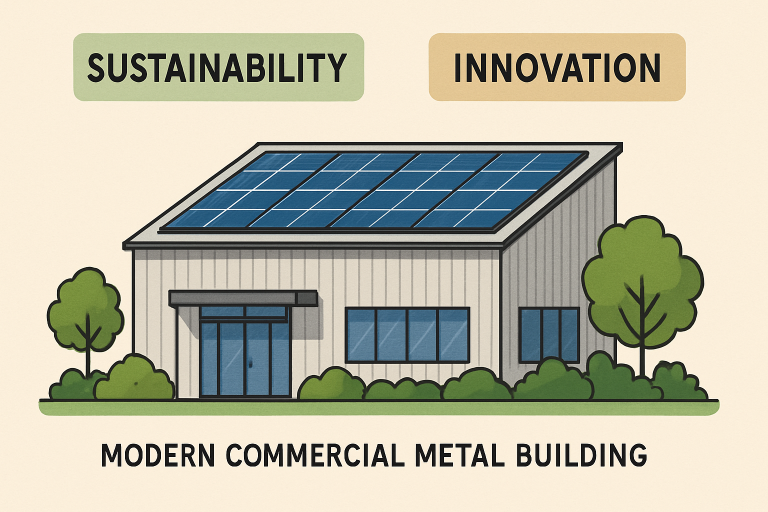Key Takeaways
- Commercial metal buildings deliver lasting versatility, resilience, and sustainability for modern businesses.
- Significant cost and operational savings are possible through more efficient construction processes and lower maintenance needs.
- Innovative materials and design trends continue to keep these structures at the forefront of future-ready commercial construction.
- Using metal as a primary material streamlines regulatory compliance and unleashes new creative opportunities in architecture.
Table of Contents
- Rising Demand for Metal Buildings
- Sustainability and Environmental Impact
- Cost Considerations and Long-Term Savings
- Design Flexibility in Modern Spaces
- Durability in Harsh Conditions
- Compliance With Building Codes and Standards
- Future Trends in Commercial Building
- Conclusion
Rising Demand for Metal Buildings
There is increasing global interest in commercial metal buildings because of their efficiency, flexibility, and durability. Because decision makers in retail, storage, office, and recreation facilities prefer commercial metal buildings, it’s important to understand that metal buildings are modular and scalable so they can be built and repurposed quickly as the business need dictates. This unique scalability and flexibility permits a business to future-proof their real estate investment and respond to changes in the market and/or business expansion. Metal buildings also allow businesses to unlock the full value of their real estate by opening or scaling new locations more quickly than conventional materials because all the components are pre-manufactured which shortens the construction time. The increasing demand is also due to a broader understanding that metal buildings can provide a contemporary, innovative space.
Sustainability and Environmental Impact
Sustainable building practices are a primary focus of modern construction, and this is a distinction of metal buildings. Steel, the primary material in most metal buildings is one of the most recycled and reused materials, which creates minimal waste and returns value back into product reuse. There are green building certifications and government incentives for commercial metal buildings that maintain down carbon footprint, increase energy performance, and minimize/reuse waste. Sustainable investments send a message of accountability along with innovation, particularly to customers and building officials.

Cost Considerations and Long-Term Savings
Cost efficiency is essential in construction, and metal buildings provide substantial savings. The use of pre-engineered materials minimizes labor hours associated with the installation and weather-related project delays, and since the steel framework requires very little maintenance, the operational expenses are even lower. An energy-efficient design that features high-performance insulation materials, reflective roofing panels, and integrated climate control systems can keep energy bills manageable. A combination of metal buildings plus modern HVAC, along with intelligent management systems, can reduce utility bills and increase occupant comfort, resulting in up to a 20-30% advantage in operating costs over traditional methods—while not giving up safety or style!
Design Flexibility in Modern Spaces
Architects and engineers are no longer designing metal buildings that are considered ugly. Advanced engineering techniques have made it possible to design commercial metal structures that work well in all type of environments, such as sports complexes, retail centers, or office campuses. These commercial metal structures can feature flexibly-designed exteriors and interiors that integrate glass, stone, wood, or color details; thereby, maintaining the durability of metal with aesthetically-pleasing design and decor. Today’s commercial metal buildings can have unique branding, open-office configuration, and work-style that stimulates productivity and maintains consistency to adhere to design boundaries.
Durability in Harsh Conditions
Businesses operating in difficult climates can rest easy knowing their considerable investment in steel buildings is resistant to pests and rot. Furthermore, metal buildings provide weather-tight and durable enclosures for safeguarding assets, advancing rear after year – creating protected longevity and value for the property. Additionally, the durability of steel buildings lessens the potential of repairs or declines in insurance cost, making metal buildings the preferred durable choice for any business to rely on for continuity and assets protection – whether in rural or urban settings.
Compliance With Building Codes and Standards
Metal buildings help meet regulatory requirements through pre-engineered systems with clear technical documentation that satisfies local, state, and federal building codes. This can result in a faster permitting process, reduced project risk, and minimized delays. A manufactured system helps speed up the approval process, and it assures owners that their building meets or exceeds safety, structural, and fire code standards. This is especially useful for businesses working in regulated industries.
Future Trends in Commercial Building
Commercial metal buildings are reshaping the construction industry by incorporating solar panel technology, insulation components, and smart control systems into commercial metal building designs to create more green design-connected buildings. Emerging trends are also beginning to include: renewable energy, adaptive climate- systems, building occupancy, and real-time building system performance monitoring. The next decade is promising for metal buildings since they serve as a flexible platform for property owners and business owners to invest. If property owners adopt the designs today, they can be confident on the return for their investments will remain attractive, efficient, and future-proof.
Conclusion
Commercial metal buildings have progressed well beyond their functional beginnings with a commendable combination of efficiency, sustainability, and design flexibility. Their affordability, regulatory flexibility, and flexibility for future technologies have made them an even more appealing investment for businesses that want to grow sustainably. The cycle of innovation will impact how energy-efficient metal buildings are the top choice when constructing new commercial spaces, whether workspaces, retail spaces, or industrial spaces.